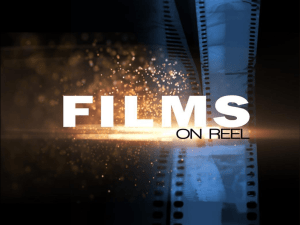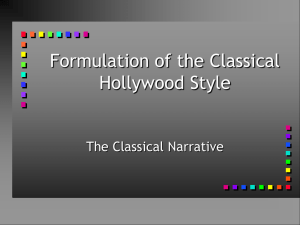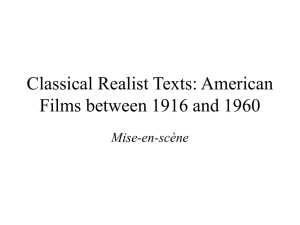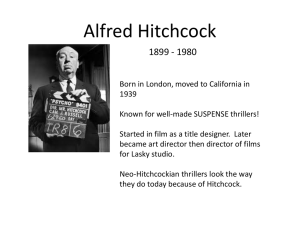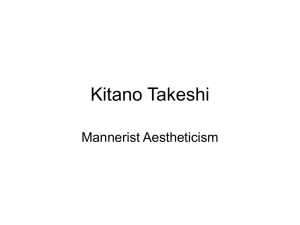Mise-en
advertisement
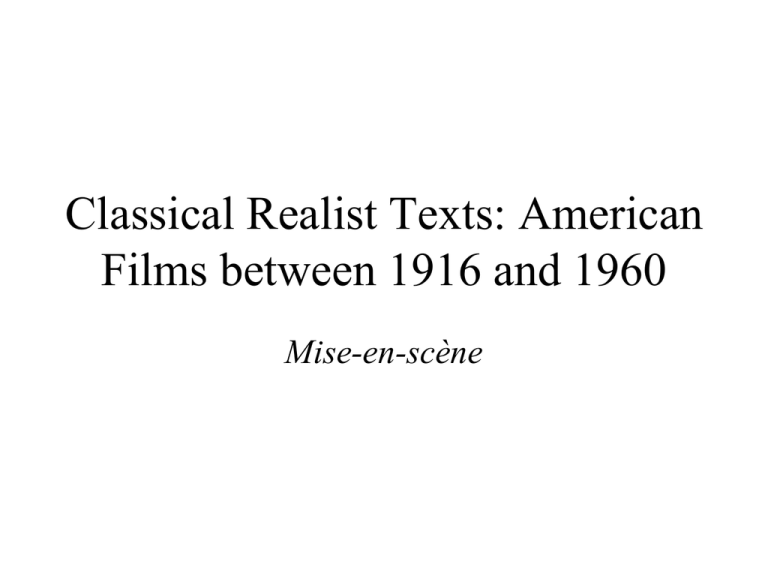
Classical Realist Texts: American Films between 1916 and 1960 Mise-en-scène Visualizing Methods in Classic American films (Mise-en-scène = ‘put it in the scene’; what is filmed, and how it is shot. It includes the directing of performance, the placement of cameras, camera movement, lighting, the choice of lenses, design, costume, location hunting, etc.) Visualizing Methods in Classic American films (Montage = editing, how to present shots. It includes cutting, mixing sound effects and music, and dubbing) Mise-en-scène in Classic American Films • Classical Hollywood films aim to make the viewer not notice that they were watching a film. They do so through telling a plausible narrative. • In making narrative the dominant force in a film, the classic Hollywood cinema chose to subordinate mise-en-scène and montage to narrative. • It lets mise-en-scène serve for the ‘invisible’, plausible and realistic narrative. Mise-en-scène in Classic American Films • They achieve reality and truth effects by concealing filming techniques through sophisticated filming techniques MISE-ENSCENE and MONTAGE • Unartificial → natural → real • Use of arts → make a film look artless → natural → real Mise-en-scène in Classic American Films • Film arts which are employed to make a film artless • No unusual angles, eye-level placing of camera, follow-focus (follow shot), no strong contrast, choice of normal size lens (35 to 50 mm), balanced composition, verisimilitudinous camera movement, etc. Mise-en-scène in Classic American Films • ANGLES OF FRAMING • High angle shot • Low angle shot • Expressive and formalist arrangement of angles in Citizen Kane (1941) • Camera angle can suggest either the vulnerability or power of a character. Mise-en-scène in Classic American Films • Straight-on angle • Following the point of view of a character the most natural positioning of the camera – angle and level Formalist Mise-en-scène • Expressive angles • Stanley Kubrick’s Clockwork Orange (1971) • Extreme low-angle shots Mise-en-scène in Classic American Films • LEVEL OF CAMERA • Low-level and highlevel placing of the camera • Following the eye level of a character - the most natural placing of the camera. Formalist Mise-en-scène • However, eye-level positioning of camera becomes expressive and formalistic, when it is set at an extreme level. • Expressive level • Danny Boyle’s Trainspotting (1996) Mise-en-scène in Classic American Films • COMPOSITION • The important figure should be placed in the slightly off-centre of the frame Mise-en-scéne in Classic American Films • Slightly off-centre composition: Douglas Sirk’s melodramas, All that Heaven Allows and Written on the Wind Formalist Mise-en-scène • Yasujiro Ozu’s famous composition in which a character comes right in the middle of the screen • Unconventional composition stands out in his films more formalist stylistic element • Ozu’s influence on Kitano films Realist and Formalist Mise-en-scène DEPTH OF FIELD: FOCUS • SELECTIVE FOCUS or SHALLOW FOCUS = only one plane is in sharp focus • To direct the viewer’s attention to that plane. Realist and Formalist Mise-en-scène • RACK(ing) FOCUS • Changing of focus within a shot in such a way that one plane of the frame goes out of focus and instead another plane comes into sharp focus. • CSI Realist and Formalist Mise-en-scène • FOLLOW FOCUS • Keeping a moving object or character in focus Realist and Formalist Mise-en-scène • DEEP FOCUS • Keeping elements at different depths of the field in focus, by using a relatively wide angle lens, strong lighting and a small camera aperture. • Preferred by realist film makers Mise-en-scène in Classic American Films • Camera movements • The camera moves following the movements of a character - the most natural way to move the camera • F.W. Murnau’s Sunrise (1927) Realist and Formalist Mise-en-Scène • In Martin Scorsese’s The Age of Innocence (1998), the camera moves following the movements of a character (point-of-view shots) • Are these camera movements more realist or more formalist. Mise-en-scène in Classical American Films • LIGHTING • High-key lighting: all areas of the image are equally lighted. • Low-key lighting: create strong contrast between light and shadow e.g. A Touch of Evil Mise-en-scène in Classic American Films • Mise-en-scene ought to be motivated as narrative does. The chain of cause and effect should dictate mise-en-scène. • e.g. When a character is a hero, he may be placed in the centre of the frame. When he walks into a room, the camera also moves with him. When he is walking in the darkness, no strong light is cast on his face. Mise-en-scéne in Classical American Films • However, Mise-en-scène should not let itself stand out. • e.g. A protagonist must be placed in the centre of the frame, but not in the dead centre. When he walks into a room, the camera also moves with him rather than it uses rack focus. When he is walking in the darkness, not too much contrast between light and shade. Mise-en-scéne in classical American films • F.W. Murnau, Sunrise: A Song of Two Humans (1927) • Travelling shot from a tram • Motivated: when the characters and the vehicle on which they are on move, the camera moves. • Sunrise
